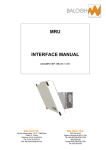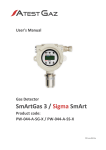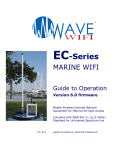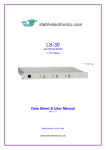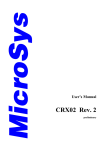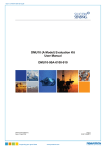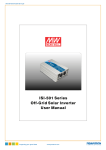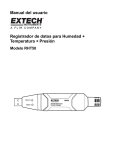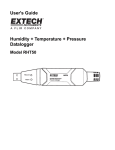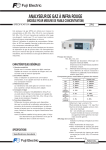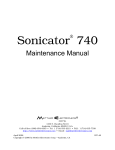Download smartMODULPREMIUM User Manual
Transcript
103-52-390-005-EH-0909.pdf smartMODULPREMIUM User Manual Anleitung_SM-Premium_V2.4 | 15.9.2009/ M.N. | Issued without guarantee, all rights reserved 1 103-52-390-005-EH-0909.pdf Content 1. General Page 3 2. Connections on the smartMODULPREMIUM Page 4 3. Connections with smartMODULPREMIUM Page 6 4. smartMODULPREMIUM output signals Page 7 4.1. Analogue signal with 0-20mA / 4-20mA or 0-1V / 0-2V (resistance) Page 7 4.2. RS485 interface 4.2.1. smartMODULPREMIUM register assignments 4.2.2. Communication via the Modbus Open Protocol 4.2.3. Example of register read offs Page 8 Page 10 Page 12 Page 16 5. Start up phase Page 18 6. Wire break between smartMODUL and interface electronics Page 18 7. Using smartMODULPREMIUM with voltage output Page 19 8. Calibrating the smartMODULPREMIUM 9. Page 20 8.1. Zero point calibration Page 21 8.2. End point calibration Page 22 Measuring cell with gas line Page 23 10. General information Page 24 Technical data Page 25 Anleitung_SM-Premium_V2.4 | 15.9.2009/ M.N. | Issued without guarantee, all rights reserved 2 103-52-390-005-EH-0909.pdf 1. General smartMODULPREMIUM combines the advantages of smartMODULFLOW with the circuit board of smartMODULCONNECT. This combination offers not only a variety of interfaces for data exchange, but also the option of controlled perfusion of the sensors via a gas inlet and outlet. Based on the physical measurement of infrared absorption, the device is not only highly selective but also provides high levels of accuracy and reliability when measuring gas concentration. Its compact construction and low maintenance needs make it ideal for use even under very difficult conditions. The smartMODULPREMIUM is ideal for creating a sensor system for measuring explosive or poisonous gases, supplying signals that can be read off either via MODBUS ASCII, as linear analogue current or output voltage. The rugged housing guarantees that the test gas remains within the measuring cell and provides the system with mechanical protection. All smartMODULPREMIUM devices can be used with the following outputs: - 4-20mA 0-20mA 0-1.0V 0-2.0 V RS 485 (3-wire) (3-wire) combined with a 50 Ohm resistance combined with a 100 Ohm communication via MODBUS ASCII The range of different signal outputs makes integration of the device into existing systems remarkably simple, reducing integration and development costs. Given the wide range of gasses and their concentrations for which the smartMODUL has already been developed, smartMODULPREMIUM from smartGAS Mikrosensorik GmbH offers the optimal basis for universal implementation as top quality IR sensory technology. Anleitung_SM-Premium_V2.4 | 15.9.2009/ M.N. | Issued without guarantee, all rights reserved 3 103-52-390-005-EH-0909.pdf 2. Connections on the smartMODULPREMIUM smartMODULPREMIUM is supplied with an operational power supply of 12 to 30V DC. Trouble-free functionality is guaranteed within this range. Despite internal stabilization, voltage supply fluctuation should be limited. In some cases, such as in plants where heavy loads are switched, the appropriate precautions need to be taken. The various connections in power supply and output signals are combined in socket ST1. Figure 1. Power supply connections Connections on ST1 are designated as follows: V+ I GND RS+ RS- Æ Æ Æ Æ Æ power supply connections (12V - 30V DC). connection for power output (selectable as 0-20mA or 4-20mA). ground/earth for V+, I and RS485. positive signal level for integrated RS485 interface. negative signal level for integrated RS485 interface. Anleitung_SM-Premium_V2.4 | 15.9.2009/ M.N. | Issued without guarantee, all rights reserved 4 103-52-390-005-EH-0909.pdf The measuring cell and interface circuitry are connected by a 30cm data cable. smartMODULPREMIUM can be supplied with cabling up to a metre length on request. The connection is made with a four-pole push connector. Figure 2. 4-pole connector Anleitung_SM-Premium_V2.4 | 15.9.2009/ M.N. | Issued without guarantee, all rights reserved 5 103-52-390-005-EH-0909.pdf 3. Connections with smartMODULPREMIUM smartMODULPREMIUM starts automatically after the start-up phase. (Section.4). Connections and signal output for the smartMODULPREMIUM are via the ST1 plug. For operation and use of the current output, the sensor must first be installed and connected. To avoid faults and possible damage to the device, we recommend adherence to the following sequence of operations: 1. Install smartMODULPREMIUM in the desired application, ensuring sufficient distance from conducting components to avoid short-circuits and possible damage. 2. Remove the green plug from the ST1 socket. The connections and clamping screws are now easy to reach. 3. Connect the power supply to V+ and GND. Connect the signal cable for current output I and GND. GND is the common ground for the power supply and current signal. Make sure that the sequence of the connections on the plug corresponds to that on the circuit board (make sure the plug is inserted correctly!). 4. re-connect the ST1 plug. The smartMODULPREMIUM starts automatically with the start-up phase (see Section 4). Anleitung_SM-Premium_V2.4 | 15.9.2009/ M.N. | Issued without guarantee, all rights reserved 6 103-52-390-005-EH-0909.pdf 4. smartMODULPREMIUM output signal 4.1 Analogue signal with 0-20mA / 4-20mA or 0-1V (0-2V (resistance) There are two options for indicating measurement values as current output. Firstly, it is possible to use a range of 0-20mA, combined with a resistance to produce a linear voltage signal. The second option is measurement output with 4-20mA. In this version, it is easier to detect a wire break, loose connection or sensor failure. The settings for the output signal are described in the following: a) 0-20mA Æ Jumper JP3 is in place (as supplied). Figure 3. Working range 0-20mA b) 4-20mA Æ Jumper JP3 not in place. Figure 4. Working range 4-20mA Select the range of output current for signal transfer you need for your application. Switching between the two ranges is possible once the device is unplugged from the power supply. . Anleitung_SM-Premium_V2.4 | 15.9.2009/ M.N. | Issued without guarantee, all rights reserved 7 103-52-390-005-EH-0909.pdf 4.2 RS485 Interface The smartMODUL PREMIUM has a RS485 interface (half-duplex). Via this interface the device can communicate via three lines: x RSinterface’s inverted data line x RS+ interface’s non-inverted data line x GND interface reference potential. This must be used for communication via the interface when the participant does not have the same zero potential (e.g. galvanic separation). The interface can be accessed via this 5-pole plug connector. Figure 5. RS485 interface connections NOTE: The RS- and RS+ lines should be bridged by at least 30 cm cable with 120 resistance inline. RS485 settings Baud rate: Data bits: Stop bits: Parity: Timeout: Retries: 2400 7 1 Even 1000ms 3 TIP: In some cases it is necessary to increase the Timeout time to 1.5s. Anleitung_SM-Premium_V2.4 | 15.9.2009/ M.N. | Issued without guarantee, all rights reserved 8 103-52-390-005-EH-0909.pdf Signal trace The signal traces at RS485 interfaces can vary greatly. The following are two examples of signals in the data line of the RS485. Example 1: RS232/RS485 converter +4.7V RS0V 70-73ms 70ms +4.7V RS+ 0V Example 2: USB/RS485 converter +4.7V RS0.4V 70-73ms 70ms +4.7V RS+ 0.4V High flexibility of amplitude is available because with RS485 the potential difference of both data lines is evaluated. In the above examples it can be seen that the difference between RS- and RS+ is 0V (inactive) or 2V (active). A short pause of max 100ms can occur. The module then replies. This depends on how many bytes need to be read off: if only one byte is read then the module reply lasts approx. 70ms. Reading off more bytes correspondingly increases the reply phase. The amplitude of the data line depends on the RS485 interface used. Anleitung_SM-Premium_V2.4 | 15.9.2009/ M.N. | Issued without guarantee, all rights reserved 9 103-52-390-005-EH-0909.pdf 4.2.1 smartMODULPREMIUM register assignments The sequence of registers in the current version is listed below; as they appear in the Host SW. Section 4.2.3 has examples of reading registers. 0xC0 Modbus_address Current Modbus status of smartMODULPREMIUM. Standard address: see Page Error! Bookmark not defined.: “Addresses”. The addresses can be written and read. After an address has been changed, subsequent communication with the smartMODULPREMIUM is only possible via this address. 0x80 – 0x83 DeviceType The type of device connected. Read only. 0x86 – 0x89 Serial Nr Serial number of device connected. Read only. 0x84 – 0x85 SoftwareVersion Software version of device connected. Read only. 0x05 MOD Assumed value for internal concentration calculation. Read only. 0x0A Konzentration Concentration is stored in this register as a numerical value. Depending on the smartMODULPREMIUM type a factor is still required for the calculation, found in the QS certificate supplied with every smartMODULPREMIUM. 0x03 T_module (0.1x°C) Internal sensor temperature, as reference point for temperature correction. Read only. 0x45 Alarm_Level Provides the threshold trigger value for the main gas alarm, referenced to the modulation value displayed for the concentration of real gas. This modulation value is reduced by one, entered in this register and can be freely set by the user. 0x44 Warn_Level Provides the threshold trigger value for the gas pre-alarm, referenced to the modulation value displayed for the concentration of real gas. This modulation value is reduced by one, entered in this register and can be freely set by the user.. Anleitung_SM-Premium_V2.4 | 15.9.2009/ M.N. | Issued without guarantee, all rights reserved 10 103-52-390-005-EH-0909.pdf 0x09 Status flags Status flags indicate the states the module can adopt. Read only. Individual flags, read from right to left, mean: Flag 0: Flag 1: Flag 2: Flag 3: Flag 4: Flag 5: Flag 6: compensated. Flag 7: Test flag, Warm-up, Syserr, Alarm, Warn, Start-up, Korr, value „1“ with device test value „1“ approx. 10s after start value „1“ device fault value „1“ with main gas alarm value „1“ with gas pre-alarm value „1“ in the start-up phase approx. 90s value „1“ when smartMODULPREMIUM is temperature- mw_ok, value „1“ when das smartMODULPREMIUM has been calibrated. Flags 6 (Korr) and 7 (mw_ok) are internal flags, set for each process smartMODULPREMIUM during production. They also have a quality control role and are set to “1” when the smartMODULPREMIUM is temperature compensated and has been calibrated. Anleitung_SM-Premium_V2.4 | 15.9.2009/ M.N. | Issued without guarantee, all rights reserved 11 103-52-390-005-EH-0909.pdf 4.2.2. Communication with the smartMODULPREMIUM via Modbus Open Protocol Reading off TTL signals provides access to a small fraction of the information logged by the smartMODULPREMIUM. Since smartMODULPREMIUM has a large amount of data potentially available it makes sense to use a BUS protocol. The Modbus Protocol basically works on the master/slave principle. The master (PC or μ controller) sends a request to the slave (smartMODULPREMIUM), which in turn answers. The duration of this phase, until all data is received, depends on how many registers need to be read. As a rule, the smartMODULPREMIUM reacts to the request within 100ms. The character string is sent directly, without reply pause. The slave does not send any data without a request. The request is always first interpreted after dispatch by CRLF. WARNING: Some programmes automatically send the CRLF; with most conventional programmes this needs to be tagged onto the string manually! The smartMODULPREMIUM sends no reply if it receives an incomplete request. This is also the case when one or more registers are absent from a register set (section request). An adapted form of the Modbus Protocol is used for smartMODULPREMIUM, differing from the standard version in that one path is used for send and receive. This ASCII protocol uses a serial half-duplex connection. Datagram structure The following section describes how a request data string to smartMODULPREMIUM is constructed. The example below shows the current modulation read off from a smartMODULPREMIUM with address 160. Example string looks as follows: :A00300050001A6 Start 1 character : Address 2 characters A0 Ctrl Com. 2 characters 03 Data 0-100 * 2 characters 00 05 00 01 checksum LRC 2 characters A6 Note: Addresses, control commands and data are prefixed with “0x” and the actual address / commands as “nn”. The “0x” merely indicates that the data is hexadecimal, but since the Modbus Protocol ASCII is defined as hexadecimal, this information is superfluous and only the address or command is transferred. The string contains no “0x” and “0x05” becomes “05”. Anleitung_SM-Premium_V2.4 | 15.9.2009/ M.N. | Issued without guarantee, all rights reserved 12 103-52-390-005-EH-0909.pdf Start: As a rule datagrams start with a colon“:”, irrespective of whether they are requests or replies. Address This defines to which device address the string is assigned. As standard, the device address is the last two digits of the MODULPREMIUM serial number as delivered. Ex.: Serial number: 22-0800-486 Æ device address: 86 Serial number: 52-0800-228 Æ device address: 28 These are added to search for module addresses. Now any register (e.g. concentration) can be requested from all module addresses (1-255) with a timeout of one second. A module with the correct address responds by sending a reply. This reply includes the module address so that at the end of the search cycle it is possible to see by processing the reply which module addresses are currently connected to the bus system. Control commands The control commands indicate what needs to be done with the addresses detected. Basically the MODULPREMIUM distinguishes between “ReadÆ0x03” and “WriteÆ0x06”. The command in the example shown here is “Read Register” (0x03Æ03) Data The register number is sent in data as a parameter. In the example here it is “Start Address High (0x00Æ00) / Low (0x05Æ05) and Number Register High (0x00Æ00) / Low (0x01Æ01)”. The Start Address High” and “Start Address Low” indicate to which register address the control command is directed; in this case, address 0005Æ0x05 “MOD”. “Number Register High” and “Number Register Low” state how many registers beginning with the start address should be read. Should 10 Registers be read, then 0010 needs to be entered. Registers 05 to 14 are read and transferred. Data is transferred in its hexadecimal form! The number of bytes doubles after conversion to from ASCII to Hex. Anleitung_SM-Premium_V2.4 | 15.9.2009/ M.N. | Issued without guarantee, all rights reserved 13 103-52-390-005-EH-0909.pdf Checksum The checksum calculates according to a LRC method (Longitudinal Redundancy Check) from all the bytes sent without CR and LF characters. The bytes are added and the sum subtracted from 0xFF. 1 is added to the result, making the LRC complete. In the example shown here the value is “A6” The checksum is always transmitted with the data and recalculated by the recipient. Should a value in the data set become corrupt, then the checksum calculated by the recipient would be different from that sent. The data set in this case would be unusable. A reply to the string above would look as follows: :A00302000109 Start Address Crtl. Com No. of bytes transferred 1 character 2 characters 2 characters 2 characters : A0 03 02 Data Checksum LRC 0-100 * 2 characters 00 01 2 characters 09 The following is an example of a checksum calculation. (Command: Read register 5 onlyÆ Modulation MOD): Data[0]:=’:’; Data[1]:=’A’; Data[2]:=’0’; Data[3]:=’0’; Data[4]:=’3’; Data[5]:=’0’; Data[6]:=’0’; Data[7]:=’0’; Data[8]:=’5’; Data[9]:=’0’; Data[10]:=’0’; Data[11]:=’0’; Data[12]:=’1’ Length=12; Note: LRC and CRLF do not belong to the data. CRLF is not included in the LRC calculation! 1. Lrc=0; For(i=1;i<Length;i++) 2. Lrc=Lrc+data[i]; //(checksum is set to 0) //(All transferred bytes are binary added with overflow (8 Bit). Example: 200+200=400. With 8 only 256Æ 144 is written = Lrc. (In this example the rest sum is 90.) 3. Lrc=0xFF-Lrc; //(From 255, subtract sum value (90)) 4. Lrc=Lrc+1; //(255-90+1=166=A6 in Hex (checksum request) Anleitung_SM-Premium_V2.4 | 15.9.2009/ M.N. | Issued without guarantee, all rights reserved 14 103-52-390-005-EH-0909.pdf Example String :A00300050001 Converted to ASCII values A = 65 0 = 48 1 = 49 3 = 51 5 = 53 Calculation: A+0+0+3+0+0+0+5+0+0+0+1 65+48+48+51+48+48+48+53+48+48+48+49=602 602-256=346 346-256=90 (Rest!) Checksum: 255-90+1=166 = A6 in hex. After calculation of the checksum the following would be sent: :A00300050001A6 The reply would yield, for example, the following: :A00302002008 (checksum 08 from reply data packet) The structure is as follows: : Start of the frame A0 -> Address sender 03 -> Register data 02 -> No. bytes (HEX!) 0020->Register data 08-> checksum reply Anleitung_SM-Premium_V2.4 | 15.9.2009/ M.N. | Issued without guarantee, all rights reserved 15 103-52-390-005-EH-0909.pdf 4.2.3 Examples of registers read offs All the following refer to a smartMODULCONECT with address 160. x Read off Device Type register Send the following string: : Start A0 Adr.160 03 read 00 80 Startregister 00 04 Register no. A0 checksum Reply: : Star t A0 Adr.16 0 03 read 08 no. bytes 53 S 4D M 2D - 43 C 4F O 32 2 20 20 64 checksum Data is transferred as characters and can be converted using an ASCII table. x Read off Serial No. register Send the following string: : Start A0 Adr.160 03 read 00 86 Start register 00 04 Register no. 9A checksum Reply: : Star t A0 Adr.16 0 03 read 08 no. bytes 32 2 30 0 08 08 00 00 019A 410 0000 99 checksum The first two bytes are transferred as characters and can be converted using an ASCII table. The third and fourth bytes are transferred as hexadecimal values and each yields a twodecimal place number. The fifth and sixth bytes are summed as a hexadecimal value and produce a three-decimal place number. x Read off Status flags register Send the following string: : Start A0 Adr.160 03 read 00 09 Start register 00 01 register no. A2 checksum Reply: : Star t A0 Adr.16 0 03 read 02 no. bytes 00C0 11000000 F7 checksum The two data bytes are summed and transferred as hexadecimal value. If this value is converted to binary number then the flags raised can be determined. x Read off Software Version register Send the following string: : Start A0 Adr.160 03 read 00 84 Start register 00 02 register no. 9E checksum Reply: : Star t A0 Adr.16 0 03 read 04 no. bytes 33 3 2E . 33 3 30 0 22 checksum The data is transferred as characters and can be converted using an ASCII table. Anleitung_SM-Premium_V2.4 | 15.9.2009/ M.N. | Issued without guarantee, all rights reserved 16 103-52-390-005-EH-0909.pdf x Read off Concentration register: Send the following string: : Start A0 Adr.160 03 read 00 0A Start register 00 01 register no. 9A checksum Reply: : Star t A0 Adr.16 0 03 read 02 no.bytes 01C8 456 EE checksum The two data bytes are summed and transferred as a hexadecimal value. If this value is converted to a decimal number, the concentration can be determined (here - 456ppm). Anleitung_SM-Premium_V2.4 | 15.9.2009/ M.N. | Issued without guarantee, all rights reserved 17 103-52-390-005-EH-0909.pdf 5 Start-up phase After power supply and current output have been connected to smartMODULPREMIUM the sensor starts a warm-up phase. This lasts approximately 90 seconds and serves as an internal check of all components and routines. The following states can occur during the warm-up phase, depending on the operating system chosen: 4-20mA: First approx. 2mA, then a jump to approx. 4mA. After approx. 90 seconds I 4mA, depending gas concentration present. 0-20mA: First 0mA. After approx. 90 seconds I 0mA depending on gas concentration present. When the warm-up phase has finished and all test routines completed trouble-free, smartMODULPREMIUM automatically switches to normal operation and displays gas concentration measured as linear current. 6. Wire break between smartMODULPREMIUM and interface electronics If the connection between a smartMODULPREMIUM and the interface electronics is interrupted (accidental separation or wire break) the following state is displayed at the current output: Operating with 4-20mA Æ Output current is frozen at 2mA. Operating with 0-20mA Æ Frozen at the last delivered current value. Depending on operating current and switching values, this state can be used as error recognition. If the fault is rectified, smartMODULPREMIUM automatically re-enters the normal warm-up phase and then switches over to normal operation when complete, as described in Section 5. NOTE: If operation with 0-20mA has been chosen the frozen current value is maintained until end of the warm-up phase. Trouble-free wire break recognition is general only possible operating with 4-20mA! Anleitung_SM-Premium_V2.4 | 15.9.2009/ M.N. | Issued without guarantee, all rights reserved 18 103-52-390-005-EH-0909.pdf 7. Using smartMODULPREMIUM with voltage output In some applications it is necessary to convert the smartMODULPREMIUM output signal into a linear voltage signal so that it can be evaluated. This is easily achieved by inserting a precision resistance into the voltage output (between I and GND). The result drop-off in voltage across the resistance reflects the concentration of the gas measured. Depending on operating current the following voltages can be set: 4-20mA Æ Æ 0.2V – 1.0V 0.5V – 2.0V 0-20mA Æ Æ 0V – 1.0V 0V – 2.0V with a 50: resistor with a 100: resistor with a 50: resistor with a 100: resistor NOTE: The maximum resistance possible for producing output signals is 125:. Anything larger would give rise to measurement error, or even in some cases, damage to smartMODULPREMIUM. The maximum permitted output voltage is 2.5V and should not be exceeded. Anleitung_SM-Premium_V2.4 | 15.9.2009/ M.N. | Issued without guarantee, all rights reserved 19 103-52-390-005-EH-0909.pdf 8. Calibrating smartMODULPREMIUM Many applications require sensor calibration after the first operational run up or at regular intervals thereafter. There are basically two types of calibration to consider. 1. Zero point calibration This serves to indicate the normal zero gas concentration to the sensor. It is not necessarily 0% gas; measuring atmospheric CO2 results in a concentration of 350 ppm – 380 ppm. Therefore the selection of zero gas is extremely important. 2. End point calibration The end point calibration serves to set the upper measurement value (UMV). This is the maximum value that can be reliably detected and measured by the sensor. When selecting sensors it is important not to set the UMV too small as this may result in inaccuracy and erroneous measurement. IMPORTANT: smartMODULPREMIUM must be run for at least 15 minutes before calibration! Anleitung_SM-Premium_V2.4 | 15.9.2009/ M.N. | Issued without guarantee, all rights reserved 20 103-52-390-005-EH-0909.pdf 8.1. Zero point calibration 1. Perfuse the sensor with zero gas, making sure the measuring cuvette has been fully purged and only zero is present. 2. Place a jumper on positions 1-2 in 1J JP4 and wait approx. 20 seconds. The value of the output current should be either 0mA or 4mA (depending on operating system), or drop to 0V or 0.5V (e.g. with 100:). Removing the jumper ends calibration and the new value is saved in the sensor. WARNING: Only run calibration with zero gas, otherwise subsequent measurements may be faulty. Figure 6. Zero calibration (Jumper on JP4, PIN 1-2) Anleitung_SM-Premium_V2.4 | 15.9.2009/ M.N. | Issued without guarantee, all rights reserved 21 103-52-390-005-EH-0909.pdf 8.2 End point calibration 1. Flood smartMODULPREMIUM with the gas concentration corresponding to the upper measurement value and make sure no residual gas is present in the cuvette. Place a jumper on positions 2-3 on JP4 and wait approx. 20 seconds. Output should increase to 20mA or 2.0V. Removing the jumper ends calibration and the new value is saved in the sensor. WARNING: Only run calibration with the appropriate gas concentration for the measurement range given, otherwise subsequent measurements may be faulty. Figure 7. Voltage calibration (Jumper auf JP4, PIN 2-3) Anleitung_SM-Premium_V2.4 | 15.9.2009/ M.N. | Issued without guarantee, all rights reserved 22 103-52-390-005-EH-0909.pdf 9.Measuring cell with gas line The smartMODULPREMIUM housing is made of aluminium to protect the sensor from mechanical damage and is with fitted with gas lines to ensure the measuring cell is flooded with the appropriate gas. The smartMODULPREMIUM housing is made of aluminium to protect the sensor from mechanical damage and is with fitted with a gas line connectors (inlet and outlet) to allow perfusion of the smartMODULPREMIUM (see Figure 8). Tubing with an internal diameter of 3mm and external diameter of 5mm is needed to connect up to the measurement cell. Ensure that tubing is securely attached to the inlet and outlet connectors. OUTLET INLET Figure 8: Measurement cell with gas inlet and outlet Adhere to the directional designation of INLET and OUTLET; switching the direction of gas flow through the cell could lead to erroneous results. NOTE: Ensure the correct type of tubing is used. In some applications, corrosive gases occur and could cause problems with the tubing material. Do not perfuse the smartMODULPREMIUM at a gas flow rate of greater than 1l per minute! Anleitung_SM-Premium_V2.4 | 15.9.2009/ M.N. | Issued without guarantee, all rights reserved 23 103-52-390-005-EH-0909.pdf 10. General information Connections not discussed in this document include: x x x x JP1 JP2 ST2 ST4 Must be left free! Production-relevant USB, production-relevant Keep free! These connectors are production-relevant and may not under any circumstances be used for normal operation. Misuse or attempts to use these connectors will damage the electronics and void the manufacturer’s guarantee! Figure 9. Additional connectors smartMODULPREMIUM may only be used with the smartMODUL supplied. To ensure and maintain the trouble functionality and compliance with the conditions of the manufacturer’s guarantee do not attempt to exchange or replace the smartMODUL supplied with another smartMODUL . Anleitung_SM-Premium_V2.4 | 15.9.2009/ M.N. | Issued without guarantee, all rights reserved 24 103-52-390-005-EH-0909.pdf Technical data Product features Measurement principle Measurement range Cuvette dimensions: H)* Gas line connectors NDIR (dual beam) dependent on model (see list of measurable gases) Length (model dependent) x 28 X 42 mm (L x W x PCB: 72 x 55 x 21 mm (L x B x H) 3mm internal, 5mm external Technical features Response time < 10 s (at 0.1l/min)* Accuracy ± 2% upper range value* Stability ±2% upper range value* over 12 month period Reproducibility <2% upper range value* Linearity error <1% upper range value* Error recognition (wire break Modul-Connect): - output current 2mA (4-20mA) - frozen output current (0-20mA) Calibration zero and voltage by jumper Operating temperature -10° C - 40° C Pressure 950 – 1050hPa** Humidity 0 – 95% rel. humidity Warm-up time < 90s (start up time)* 15 minutes (full specification)* Perfusion rate 0.5 – 1 l/min Communication Analogue output signal Digital output signal 0-20mA linear 4-20 mA linear 0-1 V linear (with 50 ) 0-2 V linear (with 100 ) Modbus ASCII via RS485 Electrical data Power supply Current demand Max load 12-30Volt DC max. 140mA 125 * ** depending on model type entering location in register 0x52 the application range in terms of pressure can be increased. Anleitung_SM-Premium_V2.4 | 15.9.2009/ M.N. | Issued without guarantee, all rights reserved 25 We are here for you. Addresses and Contacts Sales Switzerland Sales Germany Sales Austria Baden-Württemberg Region (Postcode 60000 – 79999) Rest of Germany Matthias Rüegg Ruhbergstrasse 32 CH-9230 Flawil Dieter Hirthe Mühlweg 23 D-71554 Weissach i.T. Kurt Stritzelberger Neumarkter Str. 86a D-81673 Munich Kurt Stritzelberger Neumarkter Str. 86a D-81673 Munich Tel. Mobil Fax Phone + 49 (0) 71 91 49 60 58 Mobile + 49 (0) 163 76 27 430 Fax + 49 (0) 71 91 93 31 88 Phone + 49 (0) 89 260 38 47 Mobile + 49 (0) 17 18 03 41 35 Fax + 49 (0) 89 43 10 91 91 Phone + 49 (0) 89 260 38 47 Mobile + 49 (0) 17 18 03 41 35 Fax + 49 (0) 89 43 10 91 91 [email protected] [email protected] [email protected] Sensors Power Supplies E-Components Drives Physical Sensors Peter Felder Phone + 41 (0) 44 877 35 05 [email protected] DC-DC Converters Switching Power Supplies DC-AC Inverters Sebastiano Leggio Phone + 41 (0) 44 877 35 06 [email protected] Current Converters Motors Claudio Chiffi Phone + 41 (0) 44 877 35 03 [email protected] DC Drives AC Asynchronous Motors Stepper Motors Servomotors Electrical Linear Drives DC Controllers Servo Controllers Frequency Converters Switched-mode Power Supplies Couplings Claudio Chiffi Phone + 41 (0) 44 877 35 03 [email protected] + 41 (0) 44 877 35 18 + 41 (0) 76 491 66 66 + 41 (0) 44 877 35 19 [email protected] Sales Other Countries PEWATRON AG Thurgauerstrasse 66 CH-8052 Zurich Phone + 41 (0) 44 877 35 00 Fax + 41 (0) 44 877 35 25 [email protected] www.pewatron.com Geometrical Sensors Eric Letsch Phone + 41 (0) 44 877 35 14 [email protected] Supporting your great ideas Man Machine Interface Measurement Probes Sebastiano Leggio Phone + 41 (0) 44 877 35 06 [email protected] www.pewatron.com




























